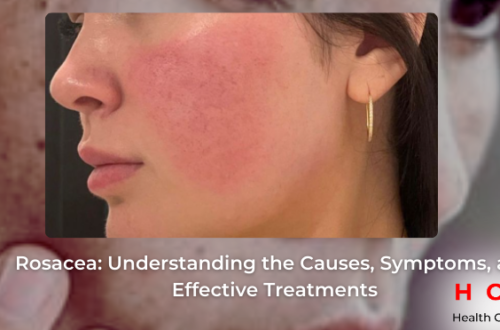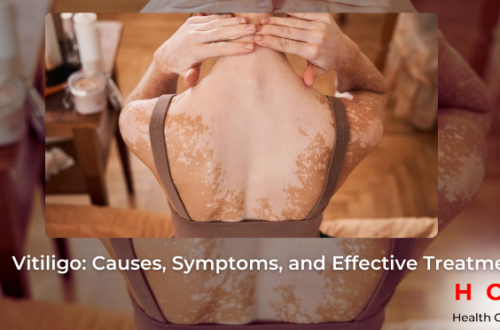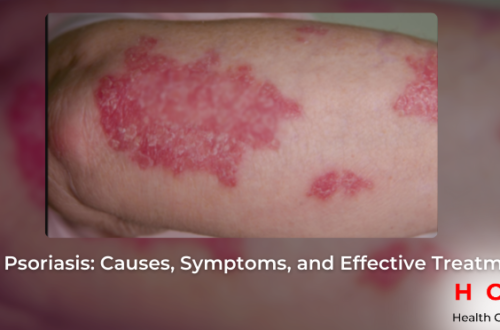
10 Common Skin Diseases: Causes, Symptoms, and Treatments
Skin diseases affect millions of people worldwide, causing discomfort, inflammation, and even serious health concerns. From mild irritations to chronic conditions, understanding different types of skin diseases is key to early diagnosis and treatment. In this article, we’ll cover 10 common skin diseases, their symptoms, causes, and treatment options.
1. Eczema (Atopic Dermatitis)
What is Eczema?
 Eczema, also known as atopic dermatitis, is a chronic condition that causes dry, itchy, and inflamed skin. It often begins in childhood and can persist into adulthood.
Eczema, also known as atopic dermatitis, is a chronic condition that causes dry, itchy, and inflamed skin. It often begins in childhood and can persist into adulthood.
Symptoms
- Red or brownish patches on the skin
- Itching, especially at night
- Dry, scaly, or cracked skin
- Fluid-filled blisters
Causes
The exact cause is unknown, but it’s believed to be linked to genetics, environmental triggers, and an overactive immune system.
Treatment
- Moisturizing creams
- Steroid creams
- Antihistamines to reduce itching
- Avoiding irritants like harsh soaps
2. Psoriasis
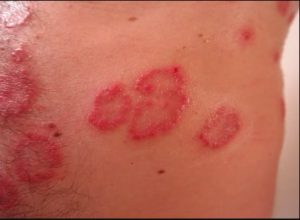
What is Psoriasis?
Psoriasis is an autoimmune disease that causes rapid skin cell turnover, leading to thick, red patches covered with silvery scales.
Symptoms
- Thick, red patches of skin with silver scales
- Itching or soreness
- Dry, cracked skin that may bleed
- Stiff, swollen joints (in cases of psoriatic arthritis)
Causes
Psoriasis occurs when the immune system mistakenly attacks healthy skin cells, speeding up the production of new cells. Genetics, stress, and infections may trigger or worsen psoriasis.
Treatment
- Topical treatments like corticosteroids
- Light therapy (phototherapy)
- Oral or injected medications for severe cases
3. Acne
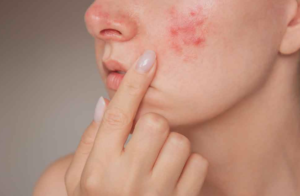
What is Acne?
Acne is a common skin condition that occurs when hair follicles become clogged with oil, dead skin cells, and bacteria.
Symptoms
- Whiteheads, blackheads, or pimples
- Cysts and nodules (in severe cases)
- Oily skin
- Scarring (if untreated)
Causes
Acne is caused by excess oil production, clogged hair follicles, bacteria, and inflammation. Hormonal changes during puberty or pregnancy often trigger acne flare-ups.
Treatment
- Over-the-counter creams and cleansers with salicylic acid or benzoyl peroxide
- Prescription topical treatments and antibiotics
- Oral contraceptives (for hormonal acne)
- Retinoids for severe cases
4. Rosacea
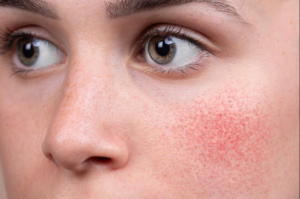
What is Rosacea?
Rosacea is a chronic skin condition that causes facial redness and visible blood vessels. It often affects the cheeks, nose, chin, and forehead.
Symptoms
- Persistent redness on the face
- Swollen red bumps that may resemble acne
- Visible blood vessels
- Eye irritation (ocular rosacea)
Causes
The exact cause of rosacea is unknown, but it may be linked to genetic and environmental factors, such as sun exposure and stress.
Treatment
- Topical and oral antibiotics
- Laser therapy for visible blood vessels
- Avoiding triggers like spicy foods, alcohol, and extreme temperatures
5. Vitiligo
What is Vitiligo?
Vitiligo is a skin disorder where the skin loses its pigment in patches due to the destruction of melanin-producing cells.
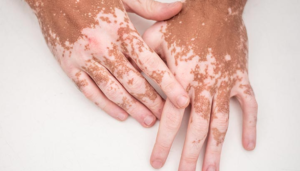 Symptoms
Symptoms
- White patches of skin
- Premature whitening of hair
- Loss of color in the mucous membranes (inside the mouth and nose)
- Discolored patches around the eyes, armpits, and groin
Causes
Vitiligo is thought to be an autoimmune condition where the immune system attacks melanocytes (the cells responsible for skin color). Genetics and environmental triggers may play a role.
Treatment
- Topical corticosteroids
- Light therapy
- Depigmentation for widespread vitiligo
- Cosmetic solutions to cover patches
6. Ringworm (Tinea)
What is Ringworm?
Ringworm is a contagious fungal infection that causes a circular, red rash with clear skin in the center, resembling a ring.
Symptoms
- Itchy, red, ring-shaped rash
- Scaly, cracked skin
- Hair loss in the affected area (if on the scalp)
Causes
Ringworm is caused by fungi known as dermatophytes. It spreads through skin-to-skin contact or contaminated surfaces, like towels or gym equipment.
Treatment
- Over-the-counter antifungal creams
- Prescription antifungal medications for severe cases
- Keeping the affected area clean and dry
7. Hives (Urticaria)
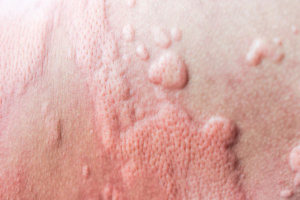 What are Hives?
What are Hives?
Hives, or urticaria, are raised, itchy welts that appear on the skin due to an allergic reaction.
Symptoms
- Raised, red or skin-colored welts
- Itching, which can be severe
- Welts that change shape or move around the body
Causes
Hives occur when the body releases histamine in response to allergens like certain foods, medications, or insect stings.
Treatment
- Antihistamines to reduce itching and swelling
- Avoiding triggers
- Corticosteroids for severe cases
8.What is Melasma?
Melasma is a skin condition that causes brown or gray patches on the face, usually on the cheeks, forehead, and upper lip.

Symptoms
- Brown or grayish patches of skin
- Symmetrical patches on both sides of the face
- Occurs more often in pregnant women or those using birth control pills
Causes
Melasma is often triggered by sun exposure, hormonal changes, or certain medications.
Treatment
- Sunscreen to prevent worsening
- Topical lightening agents like hydroquinone
- Chemical peels and laser treatments for severe cases
9. Skin Cancer
What is Skin Cancer?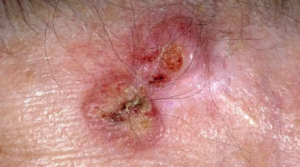
Skin cancer occurs when abnormal skin cells grow uncontrollably, leading to tumors. The most common types are melanoma, basal cell carcinoma, and squamous cell carcinoma.
Symptoms
- New or changing moles
- Sores that don’t heal
- Itchy or painful growths
- Dark streaks under nails (for melanoma)
Causes
The primary cause is prolonged exposure to UV radiation from the sun or tanning beds.
Treatment
- Surgical removal of the cancerous cells
- Radiation therapy
- Chemotherapy for advanced cases
- Regular skin exams to catch cancer early
10. Shingles (Herpes Zoster)
What is Shingles?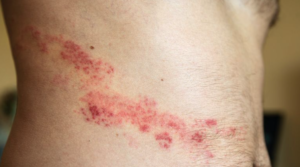
Shingles is a viral infection caused by the reactivation of the chickenpox virus, leading to a painful rash.
Symptoms
- Painful, blistering rash
- Sensitivity to touch
- Fever, headache, or fatigue
Causes
Shingles occurs when the dormant chickenpox virus (varicella-zoster) reactivates, usually later in life. Stress, aging, and a weakened immune system can trigger the virus.
Treatment
- Antiviral medications to reduce severity
- Pain relievers
- Vaccination to prevent shingles in older adults
Conclusion
While many skin diseases can be uncomfortable, most are manageable with the right treatment and lifestyle changes. It’s essential to consult a dermatologist for proper diagnosis and treatment, especially for chronic conditions like eczema, psoriasis, or skin cancer. Early detection and care are key to maintaining healthy skin and preventing complications.



